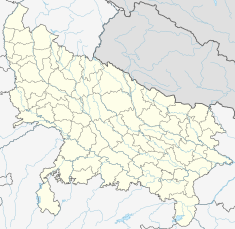Kusum Sarovar
| Kusum Sarovar | |
|---|---|
 Kusum Sarovar, Govardhan after extensive restoration, 2017 | |
| Location | Mathura district, Uttar Pradesh, India |
| Coordinates | 27°30′43.86″N 77°28′39.61″E / 27.5121833°N 77.4776694°E |
| Built for | Radha Krishna, King Suraj Mal |
| Restored by | King Jawahar Singh |
| Architectural style(s) | Rajasthani |
Location of Kusum Sarovar in Uttar Pradesh | |
Kusum Sarovar is a sacred water reservoir with a historic sand monument in its backdrop. It is situated on the holy Govardhan Hill between Manasi Ganga and Radha Kund in Mathura district of Uttar Pradesh, India.[1] Kusum Sarovar is considered one of the sacred spots that witnessed the pastimes of Hindu deities Radha and Krishna. It is also the place of Jat ruler Maharaja Suraj Mal's memorial chhatri. Kusum Sarovar has Narada Kund, where Bhakti Sutra verses were written by Narada and the Shri Radha Vana Bihari Temple in the vicinity.[2][3]
History
[edit]Kusum Sarovar was constructed by Maharaja Jawahar Singh in memory of Maharaja Suraj Mal Singh, The ruler of Bharatpur.
Radha Krishna Legend
[edit]Kusum Sarovar dates back to the era of Radha Krishna.[4] As the name suggests, Kusum Sarovar is a place surrounded by a variety of flowers and Kadamb trees. It is said that Radha would come here under the pretext of collecting flowers for her friends, but would secretly meet with Krishna and have playful conversations.[5] According to legends, once while collecting flowers, Radha's dress got stuck in thorns and Krishna came to help Radharani disguised as the gardener and took out her stuck dress from the thorns. It is also believed that Krishna used to play hide and seek with his friends on this ancient site and would collect flowers to make garlands for Radha.[1][4]
Architecture
[edit]
Kusum Sarovar Ghat
[edit]Kusum Sarovar ghat is 450 feet long and 60 feet deep tank. The ghats (banks) of pond has Rajasthani structure.[1] On all four sides of the Kusum Sarovar, there is a series of steps that lead upward to the historical building made by King Jawahar Singh. The arcade walls that surround the pond boast a depth of around 60 m.[6] Filled with emerald green water, the pond is bordered on all sides by forest containing variety of flowers.[4]

Monumental Structure
[edit]King Jawahar Singh constructed the historical monument in memory of his parents. The main tomb is dedicated to King Suraj Mal which is erected in the area of 57 square feet is located in the center of monumental structure. On both sides of this tomb, there are two other historical structures that are comparatively smaller in size. These tombs were dedicated to two queens of King Suraj Mall - Kishori and Hansiya. The entire construction is supported by a 460 feet long terrace along with a pavilion, which serves as the cover protecting both the ends of the structure.[6][7][8][9] The architecture and carving inside the tomb is in the pierced stone style and the ceiling of cenotaphs are adorned with the beautiful paintings depicting the divine pastimes of Radha Krishna and events of Maharajs Suraj Mal's court.[10][11][3][12] The structure also houses a replica of the lotus feet of Lord Krishna and Radha.[6]
Significance
[edit]Kusum Sarovar is one of the important tourist attraction of Braj region. Pilgrims from all over the country visit the lake to explore the magnificent structures that surround the Sarovar (pond) and he beautiful paintings depicting the life of Krishna and his pastimes with Radha. It is believed that Radha Krishna has performed many pastimes here. Chaitanya Mahaprabhu, a Vaishnava saint and a great devotee of Krishna also used to visit this pond during his time in Vrindavan. During the time of Chaitanya Mahaprabhu, Kusum Sarovar was also called Suman Sarovar.[1] It is said that anyone who take dips in the pond of Kusuma Sarovara will achieve pure love of Krishna.[4]
Timings
[edit]The time zone (UTC+05:30) observed through India by the local authorities[6] -
Everyday - 6:00 AM to 6:00 PM.
Gallery
[edit]-
Landscape of Kusum Sarovar
-
Side view of Kusum Sarovar
-
Artwork inside the Monument
-
Interior of Monument
-
Ghat of Kusum Sarovar
-
Pillars of monument
-
Front view of Kusum Sarovar
-
View across the Kusum Sarovar Tank towards Suraj Mal's Cenotaph, 1860s
See also
[edit]References
[edit]- ^ a b c d "Kusum Sarovar – Brijwale". Retrieved 6 July 2021.
- ^ Dev Prasad (27 January 2015). Krishna: A Journey through the Lands & Legends of Krishna. Jaico Publishing House. pp. PT 147. ISBN 978-81-8495-170-7.
- ^ a b Henry George Keene (1878). A Handbook for Visitors to Agra and Its Neighbourhood. Thacker, Spink. pp. 71–72.
- ^ a b c d vyasasan (13 February 2021). "The Beautiful Kusum Sarovar, Vrindavan". The Hare Krishna Movement. Retrieved 6 July 2021.
- ^ "Incredible India | Kusum Sarovar". www.incredibleindia.org. Retrieved 6 July 2021.
- ^ a b c d "Kusum Sarovar Govardhan | History, Interesting Facts & Best Time to Visit | UP Tourism". www.tourmyindia.com. Retrieved 6 July 2021.
- ^ Jat Kingdom of Bharatpur
- ^ "Haryana Revenue Gazeteer of Gurgaon 1910, Section B - History" (PDF). Archived from the original (PDF) on 9 October 2016. Retrieved 30 January 2019.
- ^ Frederic Salmon Growse (1883). Mathurá: A District Memoir. New Order Book Company. pp. 307–308.
- ^ Madan Prasad Bezbaruah, Dr. Krishna Gopal, Phal S. Girota, 2003, Fairs and Festivals of India: Chandigarh, Delhi, Haryana, Himachal Pradesh, Jammu and Kashmir, Punjab, Rajasthan, Uttaranchal, Uttar Pradesh, p. 480-494.
- ^ D. Anand, 1992, Krishna: The Living God of Braj, Page 56.
- ^ Frederic Salmon Growse (1883). Mathurá: A District Memoir. New Order Book Company. p. 40.
Further reading
[edit]- A. W. Entwistle (1987). "Kusum Sarovar". Braj, centre of Krishna pilgrimage. E. Forsten.
External links
[edit]![]() Media related to Kusum Sarovar at Wikimedia Commons
Media related to Kusum Sarovar at Wikimedia Commons









